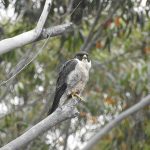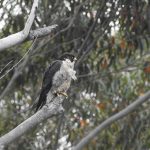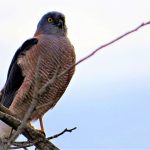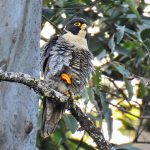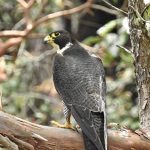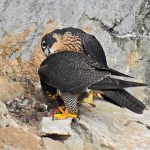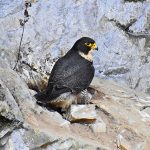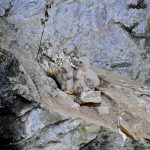PEREGRINE FALCON
Sharon:We were lucky enough to watch these amazing raptors as they reared 2 tiny chicks on the edge of a massive crater. Their rocky cliff ledge was their home for several months until the chicks grew to an age where they could fledge. The Peregrine Falcon adults were wonderful and attentive parents and would bring the tiny chicks their food, tear it apart and feed each mouthful to them. They were totally devoted. The chicks were a lovely creamy colour and covered in soft downy feathers, while the young fledglings had amazing, coloured pyjama pants and a tiny tuft of grey on their heads resembling a mohawk. It was quite nerve-racking at times watching one of the fledglings flapping his wings and trying to strengthen them, ready for his first flight. They would stand right on the edge of the cliff with no fear. The view of the chicks was quite a long zoom so please excuse the quality of this video. But enjoy, as we did, watching this ‘Close Encounter’.
The Peregrine Falcon is a remarkable bird of prey found around the world. It is known for its incredible speed and agility, making it one of the fastest animals on Earth.
Peregrine Falcons have a widespread distribution, inhabiting a variety of habitats on every continent except Antarctica. They are often found in open areas such as cliffs, coastal regions, and urban environments.
Peregrine Falcons are medium-sized raptors with a distinctive appearance. They have a dark crown and “sideburns,” which contrast with their pale undersides. Their back and wings are bluish-grey with dark bars, and they have a sharp, hooked beak.
Peregrine Falcons are renowned for their exceptional speed during hunting dives, or “stoops.” They can reach speeds of over 386 kilometers per hour during these stoops, making them one of the fastest animals on the planet. They primarily hunt other birds, capturing them in mid-air with their sharp talons.
Peregrine Falcons mainly feed on birds, particularly pigeons, doves, and other medium-sized avian prey. They use their speed and aerial agility to surprise and capture their prey during high-speed dives.
These falcons often nest on cliff ledges, but they have also adapted to nesting on tall buildings and structures in urban areas. They construct a scrape nest made of sticks, gravel, and other materials. Peregrine Falcons are known for their strong pair bonds and elaborate courtship displays.
The Peregrine Falcon’s population suffered a significant decline in the mid-20th century due to the widespread use of pesticides, particularly DDT. These chemicals caused eggshell thinning and reproductive failures. However, extensive conservation efforts, including banning DDT and implementing breeding and reintroduction programs, have led to a remarkable recovery of the species. The Peregrine Falcon’s status has improved in many regions, and it is no longer considered globally threatened.
Peregrine Falcons have a long history of association with humans, particularly in falconry. They have been used for hunting game birds for centuries due to their speed and hunting prowess.
The Peregrine Falcon is a symbol of speed, agility, and adaptability in the natural world. It serves as a testament to the power of conservation efforts in protecting and preserving threatened species.

